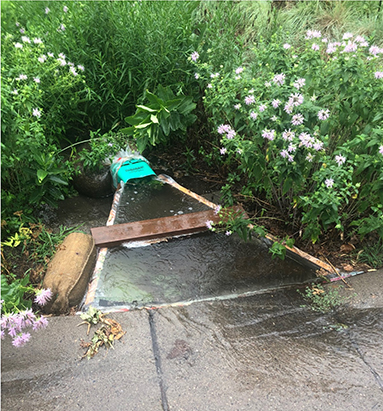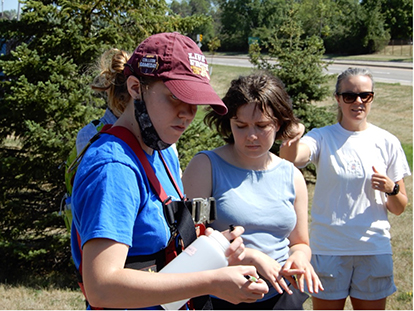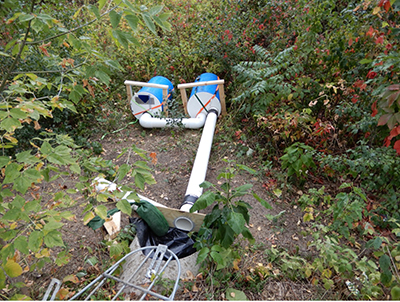Larry Baker (WRS faculty), John Chapman (PI), Grace Wilson, Jacques Finlay (WRS faculty), Aaron Pietsch, and Kathryn Hoffman
We have learned in recent years that “gross solids” – coarse organic material (COM) like tree seeds, pollen, leaves, and sticks – that fall into streets add a lot of nutrients to stormwater, plus pebbles and trash, are not included in normal stormwater sampling, which collects only tiny, suspended solids (SS). Nearly all stormwater sampling conducted up until now therefore represent only SS and not gross solids. Our stormwater management programs are blind to gross solids, making them less effective than they could be.

To gain more knowledge about stormwater gross solids, our nearly completed project Understanding Solids Loading in Minnesota Stormwater sought to learn how to quantify the movement of gross solids in stormwater and their potential impact. It was funded by the Clean Water Fund from the State of Minnesota’s Clean Water, Land and Legacy Amendment and guided by the Minnesota Stormwater Research Council. To do this, we first had to develop a new type of sampler to measure the fluxes (movement) of gross solids. Rain gardens proved to be an ideal best management practice (BMP) to sample, because most have curb cuts, pre-treatment devices, and solid land on which to install samplers. Through considerable experimentation and failure, we developed a sampler that were rugged enough to survive and collect samples for most rain events and survive intact throughout the winter (Figure 1).
Using our new samplers, we collected 400 samples of coarse organics entering rain gardens on 13 residential streets, 2 parking lots, and one arterial street over a two-year period (Figure 2). For residential streets, the average gross yields per acre of watershed were 1,438 lbs/acre/yr for wet solids and 645 lbs/yr for dry solids, of which 60% was coarse organic matter. The P yield for gross solids, 0.91 lb/acre-yr. For comparison, the Minnesota Stormwater Manual cites a value 1.0 lb/acre-yr for a typical yield of P from residential streets (based on water sampling only; no gross solids).

Although we have presumed that coarse organics are transported to rain gardens by water flowing along curbs, we have observed substantial accumulation of leaves that appear to be wind-blown. Undergraduate Natalie Narvaez is conducting an experiment to measure tree leaves in a parking lot by species and attempting to relate these species-specific inputs to nearby trees.
We also conducted an experiment to determine the relative abundance of suspended solids and coarse solids in several storm events. To do this, we constructed a stormwater collector comprised of two 55-gallon drums laid sideways, with an inlet pipe on the upstream drum that conveyed stormwater to the sampling system, a fine mesh bag attached to the inlet pipe on the inside of the first drum, and an outlet pipe that transported excess water to a second drum (Figure 3). We measured flow suspended solids (SS)in the water, and gross solids (from the mesh bag).

Initial results showed that measured total solids in stormwater runoff 3.5 to 11 times higher than SS. Gross solids therefore represented 71% to 91% of total solids. The failure to account for gross solids might be one reason that stormwater ponds fill much more quickly that estimated using models based on TSS alone.
Finally, we are using our new data to improve the capability of the P8 model. We found that mineral gravel or sand particles settled at a rate of 18 to 50 cm/s, whereas seed particles settled at an average of only 5 cm/s and tree leaves settled at an average rate of 2 cm/sec. Lucy DeBoers, an undergraduate in Bioproducts and Biosystems Engineering, has started to integrate these settling rates into the P8 model to improve its predictive capability. Organic material also has a specific gravity an order of magnitude lower than silica sand, which means that the volume of settled material in a stormwater pond might be 6-10 times higher than predicted based on conventional analysis.
This project will be a useful step leading toward improved stormwater management. More work will be needed to refine the P8 model to reflect the importance of coarse organic matter, and we need better knowledge of how coarse organic matter in storm water affects receiving water. We are now at the point where we could conduct economic optimization for a suite of management practices for managing gross solids that might include tree planting practices, targeted street sweeping, catch basins, and rain gardens.
Undergraduate technicians: Rose Coyne, Amanda Van Pelt, Freda Cozza, Lucy DeBoer and Natalie Narvaez